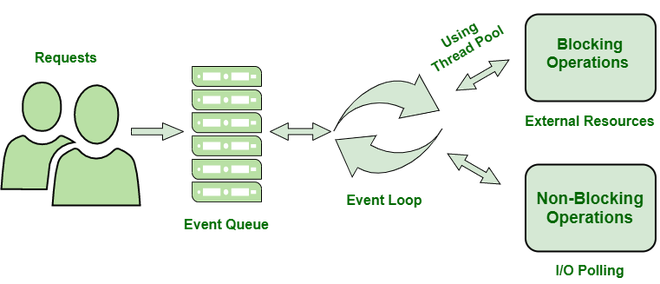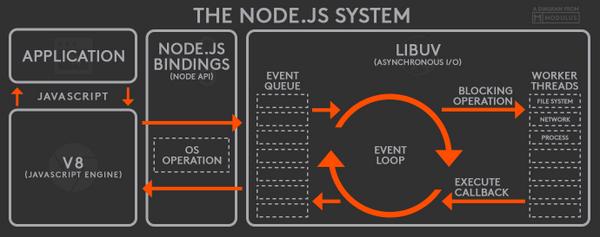An overview of Node.js Architecture
Node.js is a JavaScript runtime built on Chrome’s V8 JavaScript engine. It allows developers to execute JavaScript code on the server-side, rather than just in the browser. When developing a Node.js application, understanding its architecture is crucial for building scalable and efficient applications.
Node.js follows an event-driven, non-blocking I/O model, which means it is designed to handle concurrent connections and I/O operations efficiently. Here’s a high-level overview of the architecture of a typical node.js application.
- Event Loop: The event loop is the heart of node.js. It handles all the incoming events and executes the corresponding event handlers. It keeps running as long as there are events to process, making node.js highly responsive. The event loop allows node.js to handle concurrent requests without blocking the execution of other code.
- Single-Threaded: Node.js runs on a single thread, but it uses an event-driven model to handle concurrency. Instead of creating a new thread for each request, node.js uses a single thread to handle multiple requests concurrently. This approach is highly efficient for I/O-bound tasks.
- Non-Blocking I/O: Node.js utilizes non-blocking I/O operations, such as reading from or writing to a file or making a network request. When an I/O operation is initiated, node.js doesn’t wait for it to be completed before moving to the next task. Instead, it continues executing other operations, and once an I/O operation is finished, it notifies the corresponding callback or event handler.

Components of Node.js Architecture
Request: Depending on the expensive tasks a user wants to complete in a web application, incoming requests can be blocked (complicated) or non-blocking (simple).
Node.js server: A server-side platform called Node.js server accepts user and development team process requests and then returns results to the corresponding users.
Event Queue: A node’s event queue. Incoming client requests are stored by the js server and sent one at a development time into the Event Loop.
Thread pool: All the threads available for doing certain boring and error-prone tasks necessary to satisfy client requests are collected in a thread pool.
Event Loop: Event Loop continuously accepts requests, handles them, and sends appropriate responses to external customer engagement.
external resources: For handling client requests that are being blocked, other resources are needed. We may use these resources for processing, data storage, or other purposes.
Work flow of Node.js Architecture
Here are the following steps of Node js architecture workflow
- Requests are of two types, incoming and outgoing. Incoming requests can either be complex, which means blocking, or it can be simple, which corresponds to non-blocking. It relies on the task which is to be performed by the users in the web application or software.
- Querying for particular data refers to searching for particular data in a database.
- Deleting data which refers to sending a request to delete a particular data or performing a deleting query.
- Updating data means sending a request to change/update a particular set of data or performing an updating query on a particular row of tables to update a specific entry in the database.
- Node js retrieves the incoming clients’ requests and adds those requests to the Event Queue of node js.
- The incoming requests are then passed onto Event Loop one by one after which it checks if that request requires external resources or not. If it does then those requests get allocated with external resources or else it moves onto the next step.
- In Event Loop, non-blocking (simple) requests are processed like I/O polling and return those requests (response) to respective clients.

Advantages of Node.js Architecture
Node js server-side language gives the upper hand when compared to other server-side languages. The features of the asynchronous model and that of non-blocking I/O operation enhance the scalability and performance of Node js when integrated for other frameworks while building a web application.
- Handling multiple client requests with ease.
- No multiple threads are needed.
- Less memory and resources are required.
- Easily scalable
- High Performance
- Flexible with multiple frameworks
- Easier development process
Single threaded Node.js Architecture
Generally, we misunderstand Node.js as performing all operations in a single thread. You must be wondering how it could compete with multi-threaded frameworks.
Well, the answer is Chrome’s JavaScript V8 engine. It serves as the foundation of Node.js – an effective JavaScript runtime. This only defines that it’s built upon the single-threaded architecture of JavaScript. Therefore, a single main thread processes each request that comes from the client.
Moreover, the event loop in Node.js architecture executes (otherwise blocking) I/O operations in a non-blocking manner. It continuously monitors the asynchronous tasks (like code in your callback functions). And once they are completed, they push them back to the execution queue.
“Event Loop” is the main component of the Node.js Processing paradigm. If we understand this concept well, it becomes easier for us to have a good command on Node.js Internals.
When it comes to an asynchronous task, it has the option to set it aside and keep working on other tasks until the asynchronous task is complete. On the other hand, if you engage in prolonged, CPU-intensive tasks, it will spend too much time on one task, delaying others. In order to properly utilize the switching mechanism of the event loop, the basic idea is to avoid blocking the event loop for expensive tasks.
For the same reason, avoiding serving assets from a Node server is recommended. A CDN or S3 bucket works best for serving HTML, CSS, JavaScript files, and images. Moreover, Node.js is the right choice for applications that require numerous I/O. If you implement that correctly, the single-threaded event loop in Node.js architecture can provide performance comparable to that of an application with multiple threads.

Why does single threaded architecture work?
Node.js is designed to work on a single-threaded architecture for a few key reasons:
- Event-Driven, Non-Blocking I/O: Node.js uses an event-driven, non-blocking I/O model. When a request or I/O operation is initiated, Node.js doesn’t wait for it to be completed but registers a callback.
- Efficiency: Thread creation and management can be resource-intensive. By using a single thread for the event loop, Node.js reduces the overhead associated with thread creation, context switching, and memory consumption. This makes it more efficient and scalable, particularly for I/O-bound tasks.
- Simplicity: Single-threaded architecture simplifies the development process. Developers don’t need to worry about complex multi-threading issues such as race conditions and deadlocks. This can lead to faster development and easier debugging.
- Predictable Performance: In a multi-threaded environment, the performance of an application can be unpredictable due to varying thread execution times and contention for shared resources. Node.js provides more predictable performance since it doesn’t have to contend with other threads for CPU time.
How does blocking and no- blocking I/O work?
Blocking and non-blocking I/O are two different approaches to handling input and output operations in a computer program. They affect how a program interacts with external resources like files, network sockets, or databases.
Blocking I/O:
- In a blocking I/O operation, when a program requests some data from an external resource (e.g., reading a file or making a network request), it effectively “blocks” or pauses its execution until the operation is complete.
- During this blocking period, the program cannot perform other tasks, and it waits for the I/O operation to finish.
- This synchronous approach is simple to understand and use but can lead to inefficient resource utilization, especially in scenarios with many concurrent connections or long-latency operations.
Non-blocking I/O:
- In non-blocking I/O, a program initiates an I/O operation and continues to execute other tasks without waiting for the operation to be completed.
- The program periodically checks the status of the I/O operation or uses callbacks, events, or promises to handle the result when it becomes available.
- Non-blocking I/O allows a program to efficiently handle multiple I/O operations concurrently without blocking the entire process, making it suitable for scenarios with a large number of concurrent connections or I/O-bound tasks.
Example:
- Suppose you have a web server that needs to handle multiple incoming HTTP requests. In a blocking I/O model, for each request, the server would wait for the I/O (e.g., reading a file or querying a database) to complete before responding to the next request. This could lead to poor performance under heavy loads.
- In a non-blocking I/O model, the server can initiate I/O operations for multiple requests and continue processing other requests without waiting. When the I/O operations are complete, the server can handle the responses without blocking the overall server performance.
Best practices for developing server application
When it comes to node.js application architecture, there are several best practices and patterns that can help you build scalable, maintainable, and efficient applications. Here are some of the most commonly recommended practices and patterns:
- Modularization: Break your application into smaller modules or components based on their functionality. This promotes code reusability, maintainability, and testability. Each module should have a clear responsibility and well-defined boundaries.
- MVC (Model-View-Controller): This architectural pattern separates the application into three major components: models (data layer), views (presentation layer), and controllers (logic layer). This separation of concerns helps in organizing the codebase and makes it easier to understand and maintain.
- Middleware: Middleware functions are used to handle common tasks or add additional functionality to the request-response cycle. Examples include authentication, logging, error handling, and input validation. Middleware functions can be chained together to process requests sequentially.
- Dependency Injection: Rather than hard-coding dependencies within modules, use dependency injection to provide them from the outside. This improves testability, modularity, and flexibility. You can achieve this using library like InversifyJS, Awilix, or the built-in
dimodule in Node.js. - Asynchronous Programming: Node.js is designed to handle asynchronous operations efficiently. Utilize asynchronous patterns, such as callbacks, Promises, or async/await, to avoid blocking the event loop and make your application more responsive and scalable.
- Error Handling: Implement consistent error handling throughout your application. Centralize error handling logic to a dedicated middleware or error handler to catch and process errors uniformly. Proper error logging and reporting are also essential for troubleshooting and improving the reliability of your application
- Caching: Caching can significantly improve performance and scalability, especially for data that doesn’t change frequently.
- Authentication and Authorization: Implement secure authentication and authorization mechanisms to protect your application’s resources.
Conclusion:
In summary, Node.js architecture is a composition of components that collaborate to deliver a scalable, efficient, and event-driven runtime environment. The single-threaded, non-blocking I/O model, in tandem with the powerful Libuv library, underpins Node.js’s performance-focused design. Modules, npm, and the Event Emitter contribute to a modular and extensible codebase, while built-in modules such as HTTP and HTTPS streamline web server creation.
Empowering developers with an understanding of Node.js architecture enables them to effectively utilize its strengths in creating high-perztency applications capable of handling numerous concurrent connections. As Node.js advances, its architecture serves as a testament to the innovation and adaptability that characterizes the JavaScript ecosystem.


Leave a Comment